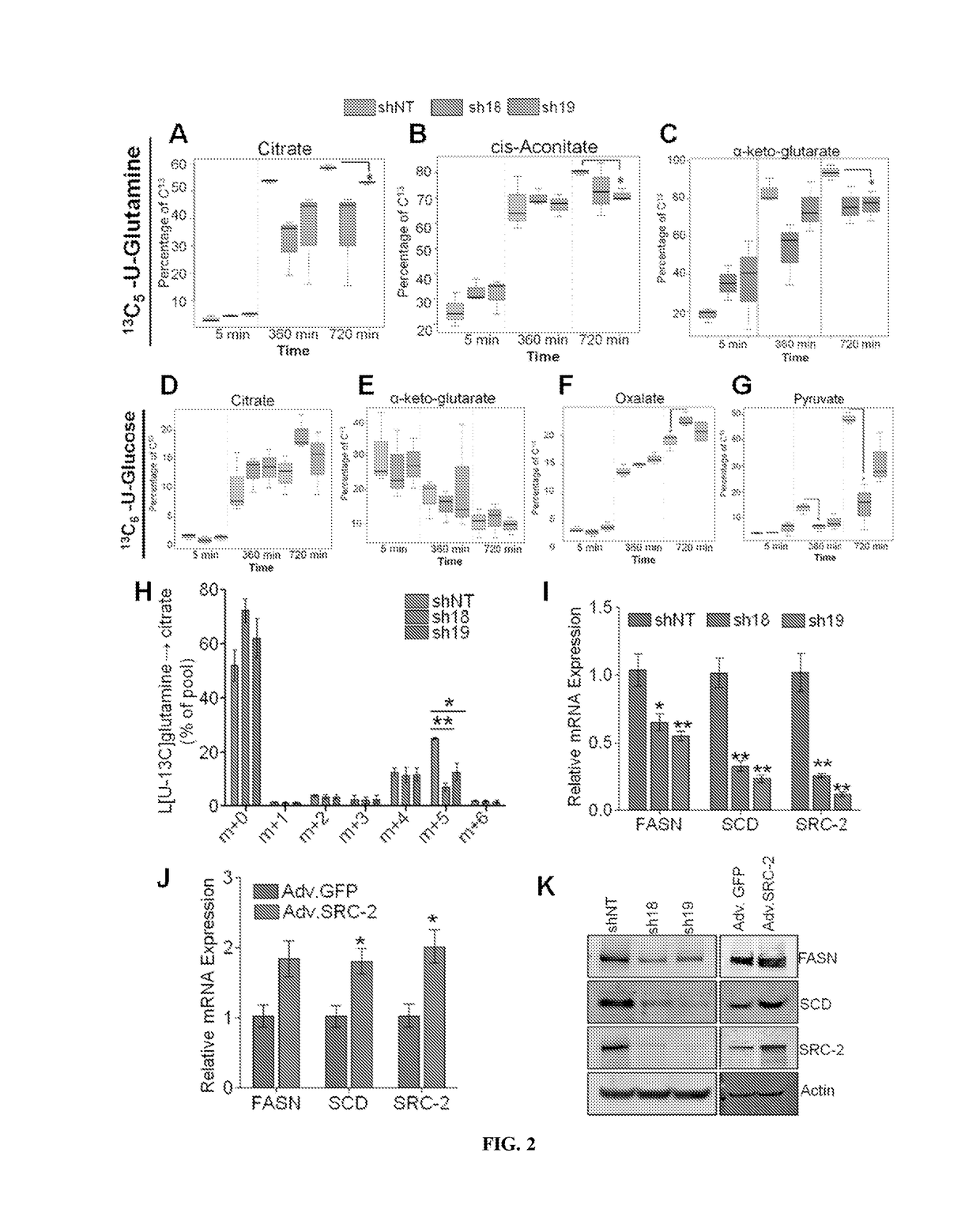Metabolic biomarker for diagnosis and treatment of metastatic prostate cancer
a metastatic prostate cancer and biomarker technology, applied in the field of biochemistry, molecular biology, cell biology, medicine, can solve the problems of poor prognosis and worse disease outcome, no study has yet investigated the functional role, and cannot efficiently detect, so as to improve the synthesis of fatty acids (lipids) and mediate the fatty acid biosynthesis
- Summary
- Abstract
- Description
- Claims
- Application Information
AI Technical Summary
Benefits of technology
Problems solved by technology
Method used
Image
Examples
example 1
SRC-2 Regulates Lipogenesis by Reductive Glutamine Metabolism
[0130]SRC-2 gene deletion studies in mice displayed severe metabolic defects particularly in fat accretion and energy homeostasis (Chopra, et al., 2008; Chopra, et al., 2011; Picard, et al., 2002; Duteil, et al., 2010). Because prostate cancer patients exhibit an increased dependency on fatty acids (Price, et al., 2002), SRC-2's role in prostate cancer lipogenesis was explored. To assess this, SRC-2 expression was stably impaired using two different clones of short hairpin RNA (sh18 and sh19) in three prostate cancer cell lines—LNCaP (FIGS. 8-A and 8-B), an androgen dependent cell line; C4-2 (FIGS. 1-A and 8-B), an androgen independent but responsive variant of LNCaP which represents the castration resistant subtype (Kosaka, et al., 2013; Liu, et al., 2004); and PC-3 (FIGS. 8-B and 8-C), an androgen receptor negative and highly metastatic line representing aggressive prostate tumors. Oil Red-O staining revealed a marked de...
example 2
Transcriptional Reprogramming Supports Lipogenesis
[0135]To understand the mechanism of SRC-2 dependent lipogenesis in prostate cancer cells, targeted gene expression analysis was performed by quantitative-PCR of enzymes (derived from KEGG) involved in glucose and lipid metabolism, TCA cycle, and glutamine metabolism. SRC-2 depletion had a broad impact on the expression of metabolic genes, among which two genes fatty acid synthase (FASN) and stearoyl-CoA desaturase (SCD), were significantly reduced upon SRC-2 silencing (FIG. 18). FASN is a multi-functional enzyme that catalyzes the biosynthesis of long-chain fatty acids from acetyl-CoA and malonyl-CoA, whereas SCD is a desaturase enzyme that synthesizes unsaturated fatty acids by incorporating double bonds into the long-chain fatty acids (Menendez & Lupu, 2007). FASN and SCD have been implicated in the progression of various types of malignancies including prostate cancer (Menendez & Lupu, 2007), but the precise mechanism regulating ...
example 3
Glutamine Uptake Stimulates SRC-2 Function
[0138]Next the upstream signaling events were investigated that direct SRC-2 to promote glutamine-dependent lipogenesis. Recent studies identified glutamine as a potent signaling molecule (Duran, et al., 2012), especially in a nutrient-stressed environment such as a glucose-deprived state, stimulating nutrient uptake and energy metabolism (Nicklin, et al., 2009). On switching C4-2 cells from high-glucose / low-glutamine media to high-glutamine / low-glucose media, there was a moderate increase in expression of two SRC-2 target genes FASN and SCD which were subsequently hindered in SRC-2 depleted cells (FIGS. 4-A and 13-A). Quite unexpectedly, there was a robust increase in SRC-2 protein level (FIG. 4-A), and not mRNA (FIG. 13-A) in glutamine-rich culture conditions, suggesting a post-translational regulation of SRC-2 in glutamine stimulated prostate cancer cells.
[0139]Post-translational modifications such as phosphorylation have the potential to...
PUM
| Property | Measurement | Unit |
|---|---|---|
| Level | aaaaa | aaaaa |
Abstract
Description
Claims
Application Information
 Login to View More
Login to View More - R&D
- Intellectual Property
- Life Sciences
- Materials
- Tech Scout
- Unparalleled Data Quality
- Higher Quality Content
- 60% Fewer Hallucinations
Browse by: Latest US Patents, China's latest patents, Technical Efficacy Thesaurus, Application Domain, Technology Topic, Popular Technical Reports.
© 2025 PatSnap. All rights reserved.Legal|Privacy policy|Modern Slavery Act Transparency Statement|Sitemap|About US| Contact US: help@patsnap.com



